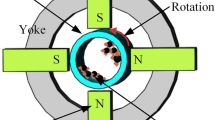Abstract
A new precision finishing process called magnetorheological abrasive flow finishing (MRAFF), which is basically a combination of abrasive flow machining (AFM) and magnetorheological finishing (MRF), has been developed for nano-finishing of parts even with complicated geometry for a wide range of industrial applications. In this paper microstructure of the mixture of magnetic and abrasive particles in magnetorheological polishing fluid (MRPF) has been proposed, and normal force on the abrasive particles is calculated from the applied magnetic field. A model for the prediction of material removal and surface roughness achieved has also been presented. And, finally theoretical results are compared with the experimental data available in the literature, and they are found to agree well.
Similar content being viewed by others
References
Jha S, Jain VK (2004) Design and development of the magnetorheological abrasive flow finishing process. Int J Mach Tools Manuf 44:1019–1029
Tao R (2001) Super-strong magnetorheological fluids. J Phys Condens Matter 13:R979–R999
Stradling AW (1993) The physics of open gradient dry magnetic separation. Int J Miner Process 39:1–18
http://www.netdenizen.com/emagnet/solenoids/solenoidonaxis.htm
Zhou L, Wen W, Sheng P (1998) Ground states of magnetorheological fluids. Phys Rev Lett 81(7):1509–1512
Jha S (2006) Magnetorheological abrasive flow finishing (MRAFF) process. Dissertation, IIT Kanpur, India
Shaw MC (1996) Principles of abrasive processing. Oxford University Press, Oxford
Jain RK, Jain VK, Dixit PM (1999) Modeling of material removal and surface roughness in abrasive flow machining process. Int J Mach Tools Manuf 39:1903–1923
Callister WD (1997) Materials science and engineering. Wiley, New York
Kim JD, Choi MS (1995) Simulation for the prediction of surface-accuracy in magnetic abrasive machining. J Mater Process Technol 53:630–642
Jha S, Jain VK, Komanduri R (2006) Effect of extrusion pressure and number of finishing cycles on surface roughness in magnetorheological abrasive flow finishing (MRAFF) process. Int J Adv Manuf Technol: DOI 10.1007/s00170-006-0502-x
Jha S, Jain VK (in press) Parametric analysis of Magnetorheological abrasive flow finishing (MRAFF) process. Int J Manuf Technol Manage, special issue on microfabrication
Author information
Authors and Affiliations
Corresponding author
Rights and permissions
About this article
Cite this article
Das, M., Jain, V.K. & Ghoshdastidar, P.S. Analysis of magnetorheological abrasive flow finishing (MRAFF) process. Int J Adv Manuf Technol 38, 613–621 (2008). https://doi.org/10.1007/s00170-007-1095-8
Received:
Accepted:
Published:
Issue Date:
DOI: https://doi.org/10.1007/s00170-007-1095-8




